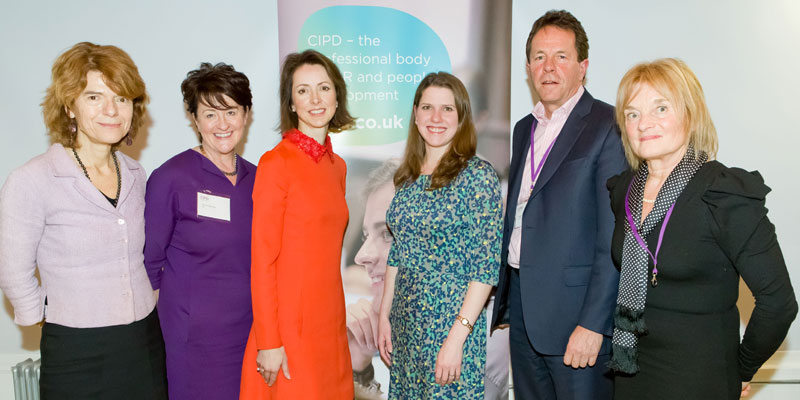In September 2012, Jo Swinson became Minister for Employment Relations and Consumer Affairs in the Department for Business, Innovation and Skills and Women and Equalities Minister. She was elected as the Liberal Democrat MP for East Dunbartonshire in 2005.

On 25th February 2015, a special CIPD event with Jo Swinson MP, Minister for Business and Women & Equalities, launched new CIPD research focusing on the status of gender diversity in the boardroom and ways to achieve a step change in the proportion of women on boards, and into senior executive positions in particular. The panel which joined the Minister included Helena Morrissey, Vicky Pryce, Ann Pickering, as well as the CIPD’s Public Policy Adviser for Diversity Dianah Worman and Chief Executive Peter Cheese, who debated the possibility of gender quotas for executive and non-executive roles as well as other initiatives for employers and policy makers in the pursuit of achieving better gender diversity.
Jo Swinson on making sure we’re properly using the talents of the women in our economy
There is a case for equality and there is a real case for making sure that we’re properly using the talents of women in our economy. The fact that we still have fewer than one in four FTSE 100 Directors being women is pretty clear that we are not yet doing that. It’s almost as though if we consider we had gender equality within the boardroom, but we didn’t have it at other levels of organisations, would that be job done? Would that be OK? Obviously no, it wouldn’t be.
So the reason we rightly target and work on the issue about women in the boardroom is because it is one symptom of a wider problem, and that wider problem is that the society we are living in which is still desperately unequal. There have been great strides and progress made over many years.
Still many gender balance battles yet to be won
I look back to previous generations of women that have fought and won many battles, but there are still many battles yet to be won, so the boardroom is just effectively a symptom of the wider problem, which is why I don’t believe that a quota response to this is actually going to come close to solving the issues that we need to solve. We absolutely need to change the culture and we absolutely need voluntary action, but just having quotas to fix the ratios in the boardroom on its own is an entirely inadequate response to the scale of the challenge.
It is right therefore that CIPD is focusing on the executive pipeline and why having made good progress on non-exec directors, that is where a huge amount of energy and attention needs to be. It’s also the case that the vast majority of women, like the vast majority of men will never serve a company board, and actually, most people would never even want to serve on a company board.
Not just boards: Making sure that change happens throughout all levels of companies
In order to make things better for our society and in workplaces up and down the country, we need to make sure that change happens throughout all the levels of companies and organisations, and that is why we need to make sure that success is properly nurtured, that talent is spotted, and that is happening at all levels, because otherwise we are not using the proper resources we have at our disposal in the economy.
Now there are various initiatives that are aiming to improve things. Opportunity Now, obviously which Helena [Morrissey] is very involved in is one such organisation. The Government’s initiative Think Act Report has been signed up to by some 270 employers covering 2.5m employees.
One of the reasons I’m so passionate about Think Act Report is that it does what it says on the tin and it is about looking at gender equality in the workplace across the piste. Yes we absolutely need to tackle the pay gap and I think there’s more that needs to be done in order to do so, but it’s not just one isolated issue. We need to be looking at recruitment processes, we need to be looking at retention, at promotion, at how women are supported within the workplace, and that’s why the companies that have signed up to Think Act Report have shown that commitment and as I say, it does what it says on the tin.
Measure the issues to know where the problems are
First of all you need to measure the issues so we know where the problems are. Is it at your intake level? Is it at that point that you’re not getting gender equality and you’re not reaching out to certain groups? Or is it at some later point? Is it at management promotion level if you’re a professional services firm? Is it fine until partner level? You need to look in good organisations at what the challenges are and analyse that information and then work out what you need to do to break down those barriers, and those will vary from organisation to organisation.
Support out daughters, nieces and girls in school to develop confidence
Sometimes they will be cultural, sometimes the issue is about confidence, and that’s a huge issue for many women, and one that you can take a lot of steps to help through networks and mentoring and support at an organisational level. What we also need to make sure from a Government level and all of us as individuals and the roles that we play with daughters, nieces, young girls coming through the school system, that we are encouraging girls to aspire and to develop that confidence.
So those barriers in organisations need to be identified and then action taken to change them, and the reporting is important, because that’s the way that you drive the accountability and the transparency.
When we’re looking at the executive pipeline, we also need to be addressing some of the basic inequalities in society about how we handle care. So we had back in the 1930s, 40s, 50s a model where basically men went out to work and once women married and had a family, they looked after the domestic arrangements, and that was the model on which it was based for many decades.
Women claiming their place in the workplace
That has rightly been broken down and women can claim their place in the workplace and they can rise to top positions in companies and be successful, but with that revolution and that change, we have not seen a revolution in the other way at anything like the pace that we need in terms of men’s role in the home.
Shared parental leave normalising childcare responsibilities for men alongside work responsibilities
So we still have the situation where women will generally be shouldering the responsibility of caring for elderly relatives, they will bear most of the responsibility for looking after children and the general domestic arrangements. We’re not going to achieve the equality we want in the workplace until we get more equality at home, which is why we’re introducing changes like shared parental leave for babies that are due from the 5th April onwards this year.
Parents will be able to choose for themselves how the split that leave and it can be that men may take the majority of the leave available, so it becomes much more normalised for men in the workplace to be saying, “I need to leave at half past five because I’m doing the nursery pick up,” or to make the request for flexible working to have different hours to manage their childcare responsibilities alongside their work responsibilities.
Banish gender stereotyping
We also need to look at the wider issues in society about sexism and about stereotyping because this starts right from the very beginning when boys and girls are going into toyshops and the dressing up outfits are being marketed that the doctors outfits are the boys’ outfits and the nurses’ outfits are the girls’ outfits and the science kits are in the boys’ toys section. There has been progress on that – some fantastic campaigns like Let Toys Be Toys, but even when this issue is raised, it is apparently seen as controversial to do so.
Socialising girls not to have confidence
I’m always struck when I go and speak to primary schools. It’s one of the most fun parts of my job talking to ten year olds. They ask absolutely the best questions, sometimes the most difficult questions! Nine times out of ten, the first child to put their hand up to ask me a question is one of the boys, so from a very early age we’re socialising girls not to put themselves forward, not to put their head above the parapet, not to have that confidence, so it is any wonder that twenty years later when it comes to negotiating a pay rise or putting themselves forward for promotion, the women might be less likely to do so?
We also have a wider culture that values women so much for how they look, which imposes absolutely unrealistic ambitions on women and what they should be aspiring to look like, so that a huge amount of energy and effort goes into that which could have been more productively directed, so I think it’s important when we’re thinking about these issues of equality in the workplace that we look at it in the whole.
#HeForShe
It’s not something that can be fixed by quotas alone. Absolutely we need to change culture and we need a huge amount of voluntary action by employers, but we also need to make sure that the battles in terms of feminism continue to be fought, and that’s by men and women.
The United Nations campaign #HeforShe is a hugely powerful movement and I welcome the fact there’s so many men here today committed to the cause of furthering gender equality in the workplace.
Read the CIPD report, Gender diversity in the boardroom: reach for the top here.
Read the CIPD blog about the event and report here.
https://www.gov.uk/government/organisations/department-for-business-innovation-skills





